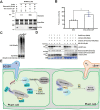Combination of in vivo proximity labeling and co-immunoprecipitation identifies the host target network of a tumor-inducing effector in the fungal maize pathogen Ustilago maydis
- PMID: 37225161
- PMCID: PMC10433927
- DOI: 10.1093/jxb/erad188
Combination of in vivo proximity labeling and co-immunoprecipitation identifies the host target network of a tumor-inducing effector in the fungal maize pathogen Ustilago maydis
Abstract
Plant pathogens secrete effectors, which target host proteins to facilitate infection. The Ustilago maydis effector UmSee1 is required for tumor formation in the leaf during infection of maize. UmSee1 interacts with maize SGT1 (suppressor of G2 allele of skp1) and blocks its phosphorylation in vivo. In the absence of UmSee1, U. maydis cannot trigger tumor formation in the bundle sheath. However, it remains unclear which host processes are manipulated by UmSee1 and the UmSee1-SGT1 interaction to cause the observed phenotype. Proximity-dependent protein labeling involving the turbo biotin ligase tag (TurboID) for proximal labeling of proteins is a powerful tool for identifying the protein interactome. We have generated transgenic U. maydis that secretes biotin ligase-fused See1 effector (UmSee1-TurboID-3HA) directly into maize cells. This approach, in combination with conventional co-immunoprecipitation, allowed the identification of additional UmSee1 interactors in maize cells. Collectively, our data identified three ubiquitin-proteasome pathway-related proteins (ZmSIP1, ZmSIP2, and ZmSIP3) that either interact with or are close to UmSee1 during host infection of maize with U. maydis. ZmSIP3 represents a cell cycle regulator whose degradation appears to be promoted in the presence of UmSee1. Our data provide a possible explanation of the requirement for UmSee1 in tumor formation during U. maydis-Zea mays interaction.
Keywords: Ustilago maydis; Fungal effectors; TurboID; maize; protein interactome; ubiquitin–proteasome.
© The Author(s) 2023. Published by Oxford University Press on behalf of the Society for Experimental Biology.
Conflict of interest statement
The authors declare no conflicts of interest.
Figures





Similar articles
-
A Secreted Effector Protein of Ustilago maydis Guides Maize Leaf Cells to Form Tumors.Plant Cell. 2015 Apr;27(4):1332-51. doi: 10.1105/tpc.114.131086. Epub 2015 Apr 17. Plant Cell. 2015. PMID: 25888589 Free PMC article.
-
Conservation of the Ustilago maydis effector See1 in related smuts.Plant Signal Behav. 2015;10(12):e1086855. doi: 10.1080/15592324.2015.1086855. Plant Signal Behav. 2015. PMID: 26357869 Free PMC article.
-
The core effector Cce1 is required for early infection of maize by Ustilago maydis.Mol Plant Pathol. 2018 Oct;19(10):2277-2287. doi: 10.1111/mpp.12698. Epub 2018 Aug 16. Mol Plant Pathol. 2018. PMID: 29745456 Free PMC article.
-
The secretome of the maize pathogen Ustilago maydis.Fungal Genet Biol. 2008 Aug;45 Suppl 1:S63-70. doi: 10.1016/j.fgb.2008.03.012. Epub 2008 Mar 31. Fungal Genet Biol. 2008. PMID: 18456523 Review.
-
[Parasitic strategy and regulation mechanism of Ustilago maydis - A review].Wei Sheng Wu Xue Bao. 2016 Sep;56(9):1385-97. Wei Sheng Wu Xue Bao. 2016. PMID: 29738207 Review. Chinese.
Cited by
-
Fungal effectors: past, present, and future.Curr Opin Microbiol. 2024 Oct;81:102526. doi: 10.1016/j.mib.2024.102526. Epub 2024 Aug 23. Curr Opin Microbiol. 2024. PMID: 39180827 Review.
-
Global organization of phenylpropanoid and anthocyanin pathways revealed by proximity labeling of trans-cinnamic acid 4-hydroxylase in Petunia inflata petal protoplasts.Front Plant Sci. 2024 Sep 19;15:1295750. doi: 10.3389/fpls.2024.1295750. eCollection 2024. Front Plant Sci. 2024. PMID: 39363925 Free PMC article.
-
A dominant-negative avirulence effector of the barley powdery mildew fungus provides mechanistic insight into barley MLA immune receptor activation.J Exp Bot. 2023 Sep 29;74(18):5854-5869. doi: 10.1093/jxb/erad285. J Exp Bot. 2023. PMID: 37474129 Free PMC article.
-
Decoding Plant-Pathogen Interactions: A Comprehensive Exploration of Effector-Plant Transcription Factor Dynamics.Mol Plant Pathol. 2025 Jan;26(1):e70057. doi: 10.1111/mpp.70057. Mol Plant Pathol. 2025. PMID: 39854033 Free PMC article. Review.
-
Effectors of plants pathogenic fungi and fungal like microbes: a comprehensive review on mechanisms, roles, and host interactions.Front Plant Sci. 2025 Jul 29;16:1626960. doi: 10.3389/fpls.2025.1626960. eCollection 2025. Front Plant Sci. 2025. PMID: 40799271 Free PMC article. Review.
References
-
- Bashir T, Dorrello NV, Amador V, Guardavaccaro D, Pagano M.. 2004. Control of the SCFSkp2–Cks1 ubiquitin ligase by the APC/CCdh1 ubiquitin ligase. Nature 428, 190–193. - PubMed
-
- Bindics J, Khan M, Uhse S, et al. . 2022. Many ways to TOPLESS—manipulation of plant auxin signalling by a cluster of fungal effectors. New Phytologist 236, 1455–1470. - PubMed
Publication types
MeSH terms
Substances
Supplementary concepts
LinkOut - more resources
Full Text Sources
Medical

